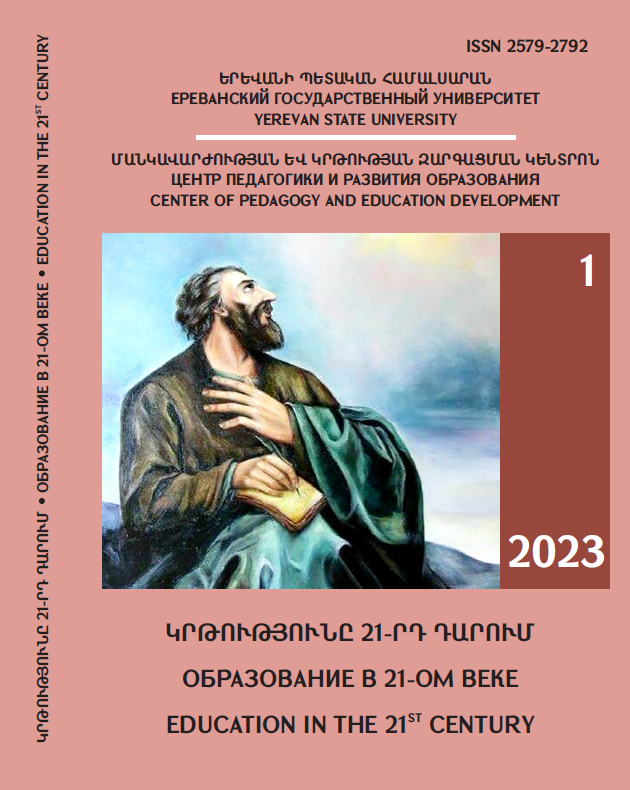ROLE OF RELIGIOUS SUBJECTS IN THE EAST ARMENIAN SCHOOLS
DOI:
https://doi.org/10.46991/ai.2023.1.235Keywords:
Yerevan seminary, East Armenian school, educational program, religious subject, school chartersAbstract
Within the framework of this study, we referred to the parish, diocesan, and monastic charters of Eastern Armenian schools approved during the reign of All Armenian Catholicos Gevorg D. We drew parallels between the Eastern Armenian school and Russian state and spiritual schools. We have analyzed the content of the education of the examined period on the example of Yerevan diocesan school. We have paid special attention to the objectives of religious subjects in general education. Based on published school charters and studies, we analyzed the educational content of Eastern Armenian parochial, diocesan, monastic schools, and discovered what religious subjects were included in those educational centers.
Until now, various researchers have reflected on the history of the Eastern Armenian school, the goals of education and upbringing, the activities of inspectors, textbooks, and teaching methods. It is interesting to find out what kind of religious courses were included in the schools of the examined period, in what order these subjects were studied, what goals they pursued. The coverage of these questions will help to form an idea about the order of study of such subjects in schools, to get acquainted with the goals of Christian education in the examined period.
Thus, Russian state and religious schools had a four-tier system. Each school graduate was admitted to the next school level. The Eastern Armenian school was formed according to the logic of the Russian state and spiritual school systems. There were no state schools, but parish, diocesan, monastic schools were formed under the auspices of the Armenian Church. Parochial and diocesan schools provided secular education. Monastic schools were entered in order to obtain the title of clergyman.
In the examined period, the Eastern Armenian educational policy was aimed at training secular specialists and clergy.
Thus, We learn from the school charters that they were included ourses with the titles "Cathexis", "History of the Old and New Testament", "Church singing", "Theology". We learn about the order in which the above-mentioned subjects were studied from the school's charters. An analysis of the subject headings provides evidence that the students received a comprehensive Christian education.
References
Աբեղյան Ա., «Գևորգ Դ. Մեծագործ կաթողիկոս ամենայն հայոց», III հրատարակություն, Էջմիածին, 2014:
Երկանյան Վ., Պայքար հայկական նոր դպրոցի համար Անդրկովկասում, Երևան, 1970թ:
Թաղիադեան Մ., Ճանապարհորդութիւն Մեսրովբայ Դ Թաղիդեանց Վ. Ա. սարկաւագի սրբոյ Էջմիածնի ի Հայս, հտ Ա,Կալկաթա, 1847:
Լեո, «Պատմութիւն Երեւանի հայոց թեմական հոգեւոր դպրոցի» 1837-1918, Թիֆլիս, 1914:
Լեո, Պատմութիւն Ղարաբաղի հայոց թեմական հոգեւոր դպրոցի: 1838-1913, Թիֆլիս, 1914:
Կանոն յաղագս ծխական հոգեւոր դպրոցացն հայոց որ ի Ռուսաստան, «Արարատ», 1868, N Զ:
Կանոնադրութիւնք յաղագս թեմական դպրոցաց Հայոց որ ի Ռուսաստան, «Արարատ», 1869, N Ժ:
Կանոնադրութիւն վանական դպրոցաց, «Արարատ», 1869, N Ա:
Հարությունյան Գ., Արցախի դպրոցն ու մանկավարժական միտքը (5-19-րդ դարերում-20-րդ դարի սկզբին), Ստեփանակերտ, 2002թ:
Ղևոնդյան Մ., Կրոնական կրթության և դաստիարակության հայկական փորձի ուսումնասիրությունները հայ կրոնամանկավարժական պարբերականներում, «Աստվածաբանական և կրոնագիտական հոդվածների ժողովածու», Երևան, 2020, N Դ:
Ղևոնդյան Մ., Ռուսական կայսրության դպրոցներում կրոն առարկայի դասավանդման հարցերի շուրջ (1800-1820 թթ), «Բանբեր Հայաստանի արխիվների», Երևան, 2021, N 2 (131):
Սանթրոսյան Մ., Արելահայ դպրոցը XIX դարի առաջին կեսին, Երևան, 1964թ:
М. А. Полякова, Краткий катехизис Мартина Лютера как феномен кросскультурного взаимодействия, «Историко-педагогический журнал», N 1, 2016:
Downloads
Published
How to Cite
Issue
Section
License
Copyright (c) 2023 Ghevondyan Mane

This work is licensed under a Creative Commons Attribution-NonCommercial 4.0 International License.

